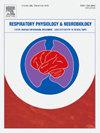呼吸感觉的神经门控作为呼吸困难感知的潜在机制:现状和未来方向。
IF 1.6
4区 医学
Q3 PHYSIOLOGY
引用次数: 0
摘要
背景:呼吸困难-呼吸不适的主观体验-是各种慢性疾病中普遍存在的衰弱症状,具有感觉,认知和情绪因素的复杂相互作用,有助于其感知。近年来,越来越多的证据表明神经处理在形成呼吸困难等症状体验中的重要性。目的:本文综述了呼吸感觉的神经门控(NGRS)作为呼吸困难感知的潜在神经机制。NGRS是通过对呼吸相关诱发电位(RREP)的重复抑制来测量的。NGRS可能反映了大脑过滤多余呼吸输入的能力,减少的NGRS可能构成厌恶性呼吸困难经历的生物标志物。回顾:我们总结了NGRS与呼吸困难之间关系的最新进展,注意到健康个体的不一致发现以及来自临床人群(如慢性阻塞性肺疾病(COPD))的有希望的证据。不一致的结果可能归因于方法上的局限性,包括实验设计和分析选择的显著可变性阻碍了NGRS的可靠性,以及自上而下的关注和期望的影响。在综述的最后部分,我们提出了NGRS-呼吸困难关系的未来研究方向,包括利用先进的脑电图分析、移动神经成像和脑刺激技术进行机制研究,以描述自上而下和自下而上的机制对NGRS的贡献。结论:通过解决目前的知识差距,本综述是促进以脑为基础的干预措施减轻慢性呼吸困难痛苦经历的集中努力的一部分。本文章由计算机程序翻译,如有差异,请以英文原文为准。
Neural gating of respiratory sensations as a potential mechanism of dyspnea perception: State-of-the-art and future directions
Context
Dyspnea – the subjective experience of breathing discomfort – is a prevalent and debilitating symptom in various chronic conditions, featuring a complex interplay of sensory, cognitive, and emotional factors contributing to its perception. In recent years, growing evidence emerged for the importance of neural processing in shaping symptom experiences such as dyspnea.
Objective
This frontiers review focuses on the neural gating of respiratory sensations (NGRS), as a potential neural mechanism underlying dyspnea perception. NGRS is measured by the repetition suppression of respiratory-related evoked potentials (RREP) elicited by paired inspiratory occlusions. NGRS may reflect the brain’s capacity to filter redundant respiratory input, and reduced NGRS may constitute a biomarker for aversive dyspnea experience.
Review
We summarize the current state-of-the-art on the relationships between NGRS and dyspnea, noting the inconsistent findings in healthy individuals along with promising evidence from clinical populations, such as chronic obstructive pulmonary disease (COPD). The inconsistent findings may be attributed to methodological limitations, including the significant variability in experimental designs and analytical choices hampering NGRS reliability, and the influence of top-down attention and expectations. In the final part of the review, we suggest future directions for the investigation of the NGRS-dyspnea relationship, including mechanistic research using advanced EEG analysis, mobile neuroimaging, and brain stimulation techniques to delineate the contributions of top-down and bottom-up mechanisms to NGRS.
Conclusions
By addressing the current knowledge gaps, this review forms a part of the concentrated effort to promote brain-based interventions for alleviating the distressing experience of chronic dyspnea.
求助全文
通过发布文献求助,成功后即可免费获取论文全文。
去求助
来源期刊
CiteScore
4.80
自引率
8.70%
发文量
104
审稿时长
54 days
期刊介绍:
Respiratory Physiology & Neurobiology (RESPNB) publishes original articles and invited reviews concerning physiology and pathophysiology of respiration in its broadest sense.
Although a special focus is on topics in neurobiology, high quality papers in respiratory molecular and cellular biology are also welcome, as are high-quality papers in traditional areas, such as:
-Mechanics of breathing-
Gas exchange and acid-base balance-
Respiration at rest and exercise-
Respiration in unusual conditions, like high or low pressure or changes of temperature, low ambient oxygen-
Embryonic and adult respiration-
Comparative respiratory physiology.
Papers on clinical aspects, original methods, as well as theoretical papers are also considered as long as they foster the understanding of respiratory physiology and pathophysiology.

 求助内容:
求助内容: 应助结果提醒方式:
应助结果提醒方式:


